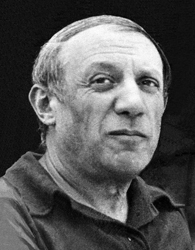From his Cubist works to his famous Blue Period, painter Pablo Picasso changed the face of art forever.
Pablo Picasso’s Early Days
Pablo Ruiz Picasso was born on October 25, 1881, in Malaga, Spain. Picasso’s father, Don Jose Ruiz Blasco, was a painter and an art teacher at a local school. Picasso was initially taught to paint by his father. His family moved to La Coruna so his father could take a better job, and then to Barcelona, where Picasso’s father became a professor at the School of Fine Arts. Picasso enrolled in classes at the school and was soon out-painting his senior classmates. In 1896, Picasso exhibited his first painting, “The First Communion,” in Barcelona. Several more successful paintings inspired Picasso’s uncle to help finance Picasso’s studies at the Royal Academy of San Fernando in Madrid, which Picasso briefly attended before scarlet fever forced him to abandon his studies and return to Barcelona to recover.
During this time, Picasso made frequent visits to the now-famous café Els Quatre Gats, where he became part of the local circle of artists who met there. In 1900, Picasso began spending time in Paris. A year later, his Blue Period began, largely inspired by the suicide of Picasso’s close friend, Carles Casamegas. During this time, Picasso’s paintings were marked by dark blue colors and morbid, desperate subject matter. Several famous works emerged from this period, including “El Entierro de Casagemas” (1901) and “La Vida” (1903).
Sources in this Story
- The Art History Archive: Pablo Picasso
- The Metropolitan Museum of Art: Cubism
- The New York Times: ART; When Picasso Spooked the F.B.I.
- Vanity Fair: The Battle for Picasso’s Multi-Billion-Dollar Empire
- Time magazine: The Time 100: Pablo Picasso
Picasso’s Notable Accomplishments
Picasso’s life took a turn for the better when he met Fernande Olivier. The two became lovers and Picasso’s happiness led to the Rose Period in 1905; his paintings took on a brighter, lighter tone. In 1907, Picasso began collaborating with French painter Georges Braque on a new style of painting that would soon be called Cubism. Cubism uses highly stylized geometrical forms to create images on the canvas. Picasso’s early Cubist works drew heavily from African art, as seen in “Les Demoiselles d’Avignon” (1907). From 1910 onward, Picasso’s works became more and more abstract, although most of these paintings were drawn from still lifes. By the end of his Cubist Period, in 1914, Picasso and Braque had achieved new levels of abstraction and experimentation that would change the face of art forever.
Throughout the 1920s and 1930s, Picasso refocused his art on neoclassicism, drawing and figure painting. Picasso also began experimenting with Surrealism and sculpture. In 1937, Picasso painted “Guernica,” inspired by the atrocities of the Spanish Civil War. During the 1940s, Picasso became a member of the Communist Party. He actively participated in the party’s peace movement, and in 1950, he was denied a visa to the United States for his political affiliation.
The Man and his Work
The Rest of the Story
By 1950, Picasso was an internationally recognized celebrity. Constantly followed by the media, Picasso secluded himself at his villa in Cannes in southern France where he continued to paint prolifically. Picasso died on April 8, 1973, of a heart attack at his home in France. At the time of his death, his estate was valued at $50 million, but managing that estate has proved difficult for his heirs.
Time magazine said of Picasso, “His death left the public with a nostalgia for genius that no talent today, in the field of painting, can satisfy.”
This article was originally written by Caleb March; it was updated October 24, 2017.











